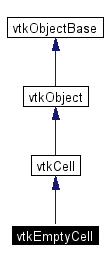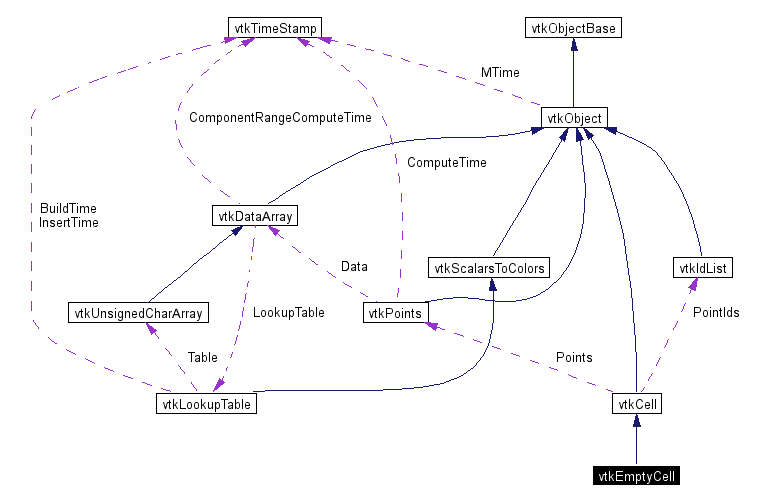vtkEmptyCell Class Reference
#include <vtkEmptyCell.h>
Inheritance diagram for vtkEmptyCell:


Detailed Description
an empty cell used as a place-holder during processingvtkEmptyCell is a concrete implementation of vtkCell. It is used during processing to represented a deleted element.
- Created by:
- Bertel, Francois
- CVS contributions (if > 5%):
- Bertel, Francois (100%)
- Tests:
- vtkEmptyCell (Tests)
Definition at line 40 of file vtkEmptyCell.h.
Public Types | |
| typedef vtkCell | Superclass |
Public Member Functions | |
| virtual const char * | GetClassName () |
| virtual int | IsA (const char *type) |
| void | PrintSelf (ostream &os, vtkIndent indent) |
| int | EvaluatePosition (double x[3], double *closestPoint, int &subId, double pcoords[3], double &dist2, double *weights) |
| void | EvaluateLocation (int &subId, double pcoords[3], double x[3], double *weights) |
| int | IntersectWithLine (double p1[3], double p2[3], double tol, double &t, double x[3], double pcoords[3], int &subId) |
| int | Triangulate (int index, vtkIdList *ptIds, vtkPoints *pts) |
| void | Derivatives (int subId, double pcoords[3], double *values, int dim, double *derivs) |
| int | GetCellType () |
| int | GetCellDimension () |
| int | GetNumberOfEdges () |
| int | GetNumberOfFaces () |
| vtkCell * | GetEdge (int) |
| vtkCell * | GetFace (int) |
| int | CellBoundary (int subId, double pcoords[3], vtkIdList *pts) |
| void | Contour (double value, vtkDataArray *cellScalars, vtkPointLocator *locator, vtkCellArray *verts1, vtkCellArray *lines, vtkCellArray *verts2, vtkPointData *inPd, vtkPointData *outPd, vtkCellData *inCd, vtkIdType cellId, vtkCellData *outCd) |
| void | Clip (double value, vtkDataArray *cellScalars, vtkPointLocator *locator, vtkCellArray *pts, vtkPointData *inPd, vtkPointData *outPd, vtkCellData *inCd, vtkIdType cellId, vtkCellData *outCd, int insideOut) |
Static Public Member Functions | |
| vtkEmptyCell * | New () |
| int | IsTypeOf (const char *type) |
| vtkEmptyCell * | SafeDownCast (vtkObject *o) |
Protected Member Functions | |
| vtkEmptyCell () | |
| ~vtkEmptyCell () | |
Member Typedef Documentation
|
|
Reimplemented from vtkCell. Definition at line 44 of file vtkEmptyCell.h. |
Constructor & Destructor Documentation
|
|
Definition at line 80 of file vtkEmptyCell.h. |
|
|
Definition at line 81 of file vtkEmptyCell.h. |
Member Function Documentation
|
|
Create an object with Debug turned off, modified time initialized to zero, and reference counting on. Reimplemented from vtkObject. |
|
|
Reimplemented from vtkCell. |
|
|
Return 1 if this class type is the same type of (or a subclass of) the named class. Returns 0 otherwise. This method works in combination with vtkTypeRevisionMacro found in vtkSetGet.h. Reimplemented from vtkCell. |
|
|
Return 1 if this class is the same type of (or a subclass of) the named class. Returns 0 otherwise. This method works in combination with vtkTypeRevisionMacro found in vtkSetGet.h. Reimplemented from vtkCell. |
|
|
Reimplemented from vtkCell. |
|
||||||||||||
|
Methods invoked by print to print information about the object including superclasses. Typically not called by the user (use Print() instead) but used in the hierarchical print process to combine the output of several classes. Reimplemented from vtkCell. |
|
|
See the vtkCell API for descriptions of these methods. Implements vtkCell. Definition at line 49 of file vtkEmptyCell.h. |
|
|
See the vtkCell API for descriptions of these methods. Implements vtkCell. Definition at line 50 of file vtkEmptyCell.h. |
|
|
See the vtkCell API for descriptions of these methods. Implements vtkCell. Definition at line 51 of file vtkEmptyCell.h. |
|
|
See the vtkCell API for descriptions of these methods. Implements vtkCell. Definition at line 52 of file vtkEmptyCell.h. |
|
|
See the vtkCell API for descriptions of these methods. Implements vtkCell. Definition at line 53 of file vtkEmptyCell.h. |
|
|
See the vtkCell API for descriptions of these methods. Implements vtkCell. Definition at line 54 of file vtkEmptyCell.h. |
|
||||||||||||||||
|
See the vtkCell API for descriptions of these methods. Implements vtkCell. |
|
||||||||||||||||||||||||||||||||||||||||||||||||
|
See the vtkCell API for descriptions of these methods. Implements vtkCell. |
|
||||||||||||||||||||||||||||||||||||||||||||
|
See the vtkCell API for descriptions of these methods. Implements vtkCell. |
|
||||||||||||||||||||||||||||
|
Given a point x[3] return inside(=1) or outside(=0) cell; evaluate parametric coordinates, sub-cell id (!=0 only if cell is composite), distance squared of point x[3] to cell (in particular, the sub-cell indicated), closest point on cell to x[3] (unless closestPoint is null, in which case, the closest point and dist2 are not found), and interpolation weights in cell. (The number of weights is equal to the number of points defining the cell). Note: on rare occasions a -1 is returned from the method. This means that numerical error has occurred and all data returned from this method should be ignored. Also, inside/outside is determine parametrically. That is, a point is inside if it satisfies parametric limits. This can cause problems for cells of topological dimension 2 or less, since a point in 3D can project onto the cell within parametric limits but be "far" from the cell. Thus the value dist2 may be checked to determine true in/out. Implements vtkCell. |
|
||||||||||||||||||||
|
Determine global coordinate (x[3]) from subId and parametric coordinates. Also returns interpolation weights. (The number of weights is equal to the number of points in the cell.) Implements vtkCell. |
|
||||||||||||||||||||||||||||||||
|
Intersect with a ray. Return parametric coordinates (both line and cell) and global intersection coordinates, given ray definition and tolerance. The method returns non-zero value if intersection occurs. Implements vtkCell. |
|
||||||||||||||||
|
Generate simplices of proper dimension. If cell is 3D, tetrahedron are generated; if 2D triangles; if 1D lines; if 0D points. The form of the output is a sequence of points, each n+1 points (where n is topological cell dimension) defining a simplex. The index is a parameter that controls which triangulation to use (if more than one is possible). If numerical degeneracy encountered, 0 is returned, otherwise 1 is returned. Implements vtkCell. |
|
||||||||||||||||||||||||
|
Compute derivatives given cell subId and parametric coordinates. The values array is a series of data value(s) at the cell points. There is a one-to-one correspondence between cell point and data value(s). Dim is the number of data values per cell point. Derivs are derivatives in the x-y-z coordinate directions for each data value. Thus, if computing derivatives for a scalar function in a hexahedron, dim=1, 8 values are supplied, and 3 deriv values are returned (i.e., derivatives in x-y-z directions). On the other hand, if computing derivatives of velocity (vx,vy,vz) dim=3, 24 values are supplied ((vx,vy,vz)1, (vx,vy,vz)2, ....()8), and 9 deriv values are returned ((d(vx)/dx),(d(vx)/dy),(d(vx)/dz), (d(vy)/dx),(d(vy)/dy), (d(vy)/dz), (d(vz)/dx),(d(vz)/dy),(d(vz)/dz)). Implements vtkCell. |
The documentation for this class was generated from the following file:
- dox/Filtering/vtkEmptyCell.h